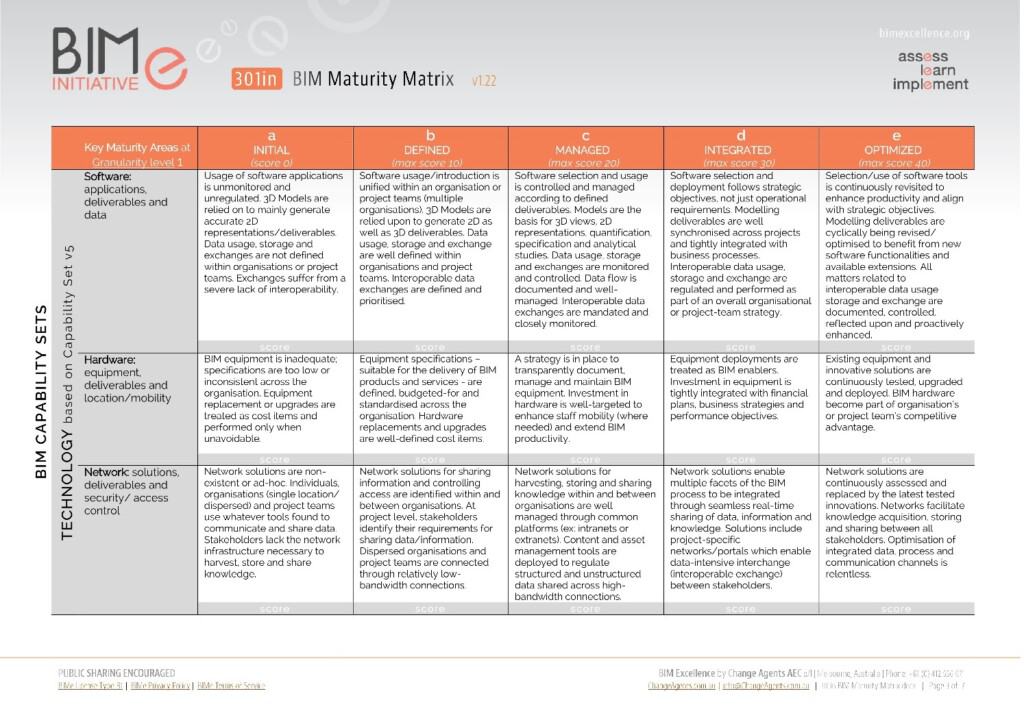According to NBS National BIM Report1, there has been a significant rise in the adoption of BIM in the past decade, with 73% of construction companies reporting that they are aware of BIM and are using it within their companies, which has risen significantly from a mere 11% in 2011.
The survey result proves that the Architecture, Engineering, Construction and Operations (AECO) industry is set for changes. Moving forward from mere conceptualization, digital construction and implementation is thriving around the world. A quantifiable evaluation system is needed to ensure one is on the right track toward this trend.
At RLB, we have been pushing BIM’s capabilities, finding ways to amplify the benefits, potential and value on our projects by developing an automatic information extraction system from models that enables us to respond directly to client needs and thus achieving better cost management of projects. As one of the stakeholders in the AECO industry, we believe that a sound evaluation on the company’s BIM capabilities is required. It will provide insights on areas for improvement, which helps determine focus areas of a company’s development roadmap. In this article, we are going to share our experience of measuring the BIM maturity level of our Hong Kong office by using the BIM Maturity Matrix (BIm3)2.
BIM MATURITY EVALUATION
METHODOLOGY
Developed by BIMe Initiative3, the BIm3 is one of the evaluation tools for identifying the current BIM Maturity of an organization. It is a research-based approach for assessing and improving the current performance of individuals, organizations and project teams. The matrix has two axes: BIM Capability Sets and the BIM Maturity Index (BIMMI).
BIM Capability Set is a taxonomy representing BIM Player’s abilities to satisfy a BIM Requirement or generate a BIM Deliverable, while BIMMI is a metric to measure BIM Maturity of organizations, project teams and whole markets. BIMMI has five distinct BIM Maturity Levels: (a) Ad-hoc, (b) Defined, (c) Managed, (d) Integrated and (e) Optimized.


ASSESSMENT
The BIM Maturity is assessed in the fields of technology, process, policy and people.
TECHNOLOGY
There are 3 Key Maturity Areas under Technology.
- Software
This Area is about the maturity in the selection/use of software tools, which could enhance productivity. Besides, modelling deliverables should not be used for generating 2D drawings only, but tightly integrating with business processes for 3D views, 2D representations, quantification, specification and analytical studies. Data usage, storage and exchanges should focus on interoperability, documentation and monitoring.
- Hardware
This Maturity Area highlights the importance of hardware investment for enhancing staff mobility and productivity. Therefore, solutions should be constantly tested, upgraded and optimized to become part of organization’s competitive advantage.
- Network
Network solutions are tools for communication and data sharing. Security requirements of stakeholders should be aware of and are regularly assessed and replaced by the latest tested innovation.
PROCESS
There are 4 Key Maturity Areas under Process.
- Resources
The work environment is considered as a factor for improving staff satisfaction, motivation and productivity. Knowledge is an asset, therefore it should be harvested and documented, and made accessible and easily retrievable.
- Activities & Workflows
This Maturity Area requires the ability to continuously upgrade the BIM roles and competency targets to match technology advances and align with organizational objectives. Steady flow of information ensures predictable and consistent productivity.
- Products & Services
3D models deliverables should be specified and differentiated by BIM Specifications. This Area emphasizes the importance of evaluation and feedback loops which could promote continuous improvement.
- Leadership & Management
Higher maturity level is achieved if BIM vision could be shared by all staff across the organization and/or project partner. Revisiting the BIM implementation strategy regularly with detailed action plans and monitoring regimes are required. Business opportunities arising from innovation/ BIM could be used in marketing to attract and retain clients.
POLICY
There are 3 Key Maturity Areas under Policy.
- Preparatory
BIM training should be based on staff roles and respective competency objectives and will be continuously evaluated and improved upon. Training mediums and delivery methods are tailored and allow multi-model continuous learning.
- Regulatory
This Maturity Area is about the continuous and proactive refining of modelling and documentation standards which can reflect lessons learned and industry best practices. It is necessary to repetitively revisit the quality target and benchmarks to ensure the highest possible quality in processes, products and services.
- Contractual
Contractual models are needed to manage shared BIM intellectual property, confidentiality, liability and a system for BIM conflict resolution to achieve best practices and the highest value for all stakeholders.
PEOPLE
There are 3 Key Maturity Areas under People.
- Organizations
BIM roles should be integrated into organization’s leadership structures to allow for new technologies, processes and deliverables.
- Project Teams
This Maturity Area requires the stakeholders to think beyond a single project. Collaborative projects are undertaken by self-optimizing inter-disciplinary project teams which include most stakeholders.
- Markets
BIM components should be integrated into central repositories and could be retrieved in BIM software with source databases (for price, availability, etc.) linked.
EXPERIENCE SHARING IN ACHIEVING HIGHER MATURITY LEVEL
In Hong Kong, growing government initiatives of BIM adoption is contributing to the growth of the BIM market. The growth has enabled the BIM software market to expand significantly. Therefore, keeping an eye on the new software available in the market and revisiting software version’s updates are needed to benefit from new software functionalities and available extension, e.g. dynamo, programming, A.I. and dashboard.
By utilizing the data contained within the BIM model, accurate and efficient quantity take-off process can be achieved. The key to success in delivering is to adopt an integrated collaborative approach. The BIM requirements for cost estimation need careful liaison with the BIM-authors in different project stages in order to effectively solve project-specific issues. “RLB 5D BIM Standards for Use in Hong Kong” specifies and differentiates the cost-related information to be included in BIM models. Higher Maturity Level could be achieved by working with the Delivery Team from early stage of the project.
Besides, experience sharing sessions, including lessons learnt from previous BIM projects and industry best practices, can be conducted among internal project teams and cross-project stakeholders.
Holding BIM training based on staff roles and respective competency object is essential. This target-oriented approach sets out clear teaching and learning targets and enables staff to acquire higher standards of BIM knowledge and techniques in a timely manner. It is also beneficial to review the training materials with the shared knowledge gained in projects.
COVID-19 has been the catalyst for organization to accelerate digital transformation plans. Most organizations aim to ease the burdens placed on the traditional business model by remote working. The e-Tendering system provides solutions.
Last but not the least, top management support plays a vital role in the success of the BIM implementation strategy. Their supports help to get necessary resources (facility, capital, IT, and human resource) and ultimately upgrade the BIM Maturity.
THE WAY FORWARD
Having a good understanding of our maturity level, we can implement a strategic plan for improving our BIM process. Regular self-assessment should be carried out for continuous improvement. Furthermore, we would review our BIM approach from time to from to keep abreast of the industry trend. That helps us shape a better built environment in the industry through the application of technologies in digitalization.
1https://www.thenbs.com/knowledge/national-bim-report-2020
FURTHER INFORMATION:


